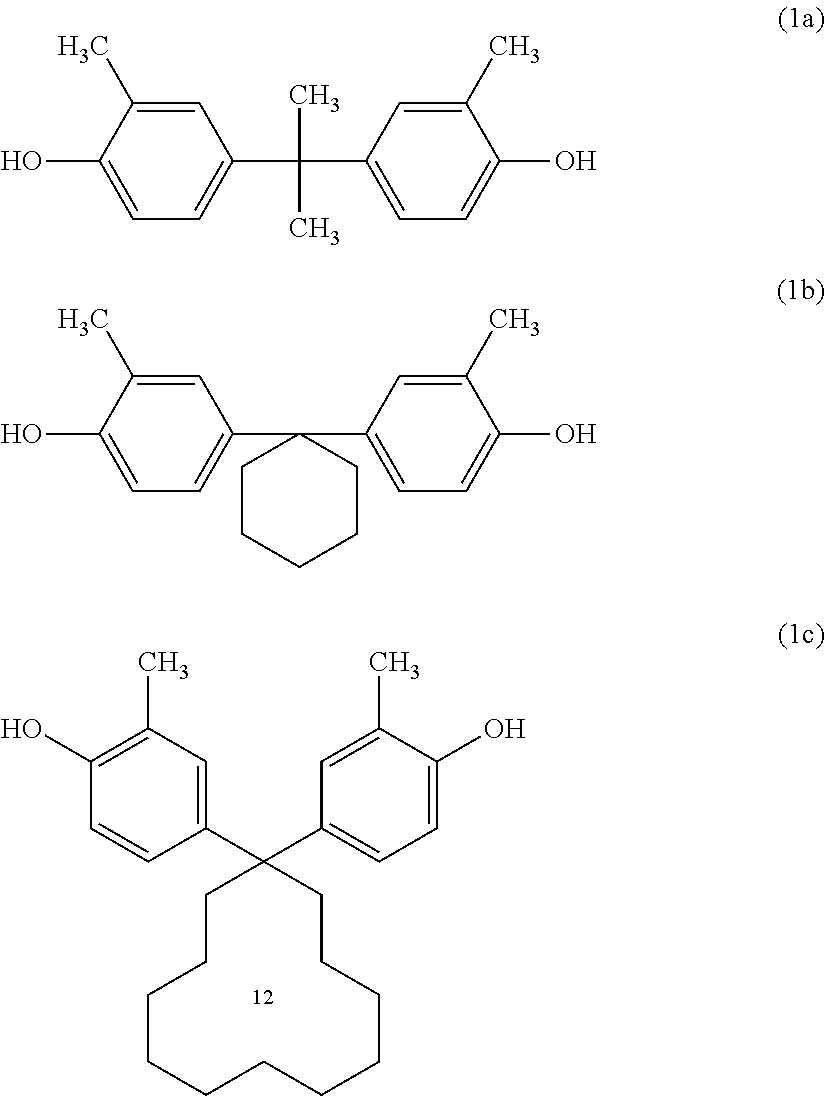Polycarbonate resin composition, method for producing same and molded article of this resin composition
a polycarbonate resin and composition technology, applied in the field of polycarbonate resin composition and a method for producing it, and a molded article of the resin composition, can solve the problems of not being able being unable to meet the requirements of a wide range of applications, etc., to achieve excellent heat resistance, excellent surface hardness, and excellent heat resistance.
- Summary
- Abstract
- Description
- Claims
- Application Information
AI Technical Summary
Benefits of technology
Problems solved by technology
Method used
Image
Examples
reference example 1
Preparation of PC(a1)
[0231]To 37.6 kg (about 147 mol) of 2,2-bis(4-hydroxy-3-methylphenyl)propane (hereinafter sometimes referred to as “BPC”) (manufactured by HONSHU CHEMICAL INDUSTRY CO., LTD.) and 32.2 kg (about 150 mol) of diphenyl carbonate (DPC), an aqueous solution of cesium carbonate was added so that cesium carbonate would be 2 μmol per 1 mol of BPC to prepare a mixture. Then, the mixture was charged into a first reactor having an internal volume of 200 L equipped with a stirring machine, a heat medium jacket, a vacuum pump and a reflux condenser.
[0232]Then, an operation of reducing the pressure in the first reactor to 1.33 kPa (10 Torr) and then recovering it to the atmospheric pressure by nitrogen was repeatedly carried out five times, and then the interior in the first reactor was replaced with nitrogen. After replacement with nitrogen, a heat medium at a temperature of 230° C. was passed through the heat medium jacket to gradually increase the internal temperature in th...
reference example 2
Preparation of PC(a2)
[0235]In the same manner as in Reference Example 1, an ester exchange reaction in the first reactor was carried out for 80 minutes. Then, the pressure in the system was recovered to 101.3 kPa by the absolute pressure with nitrogen, and then the pressure was elevated to 0.2 MPa by the gauge pressure, and by means of a transfer pipe preliminarily heated to at least 200° C., the oligomer in the first reactor was pumped to a second reactor. The second reactor had an internal volume of 200 L, was equipped with a stirring machine, a heat medium jacket, a vacuum pump and a reflux condenser, and had the internal pressure and the internal temperature controlled to the atmospheric pressure and 240° C.
[0236]Then, the oligomer pumped to the second reactor was stirred at 38 rpm, the internal temperature was raised by the heat medium jacket, and the pressure in the second reactor was reduced from 101.3 kPa to 13.3 kPa by the absolute pressure over a period of 40 minutes. Then...
reference examples 3 and 4
Preparation of PC(a3) and PC(a4)
[0238]A reaction was carried out in accordance with Reference Example 2 except that the preliminarily determined stirring power of the stirring machine of the second reactor at the time of completion was changed. Then, the pressure in the second reactor was recovered to 101.3 kPa by the absolute pressure with nitrogen, and then the pressure was elevated to 0.2 MPa by the gauge pressure, the polycarbonate resin was withdrawn from the bottom of the second reactor in the form of strands, which were pelletized by using a rotary cutter while cooling in a water tank.
[0239]That is, by changing the preliminarily determined stirring power of the stirring machine of the second reactor at the time of completion, a polycarbonate resin (PC(a3)) and a polycarbonate resin (PC(a4)) were respectively obtained. The viscosity average molecular weight, the glass transition temperature (Tg) and the pencil hardness are as shown in Table 1.
PUM
| Property | Measurement | Unit |
|---|---|---|
| yellowness index | aaaaa | aaaaa |
| pencil hardness | aaaaa | aaaaa |
| weight ratio | aaaaa | aaaaa |
Abstract
Description
Claims
Application Information
 Login to view more
Login to view more - R&D Engineer
- R&D Manager
- IP Professional
- Industry Leading Data Capabilities
- Powerful AI technology
- Patent DNA Extraction
Browse by: Latest US Patents, China's latest patents, Technical Efficacy Thesaurus, Application Domain, Technology Topic.
© 2024 PatSnap. All rights reserved.Legal|Privacy policy|Modern Slavery Act Transparency Statement|Sitemap



